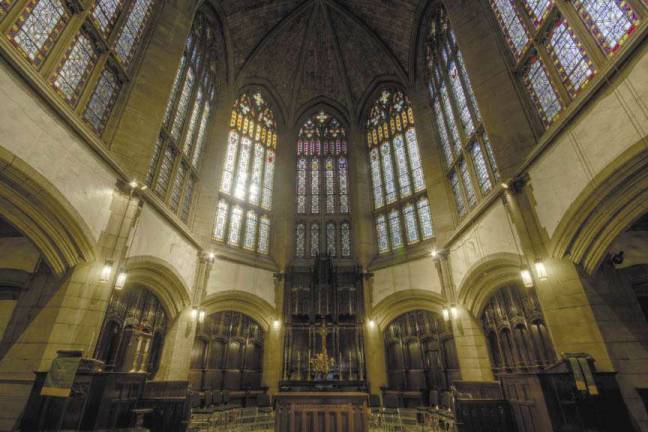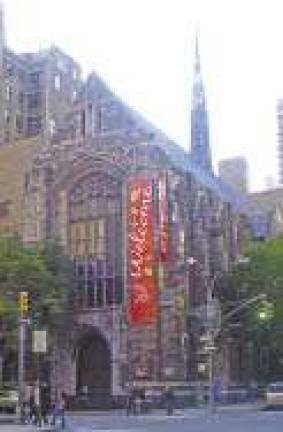The Congregation Versus the Community


Churches and synagogues throughout Manhattan facing economic hardship may find their financial plans thwarted by preservation efforts
It's hard to argue against preserving the city's historic, soaring monuments to God. Churches and synagogues throughout Manhattan have been targeted by preservation enthusiasts since the city first created the Landmarks Preservation Commission in 1965. They have good reason: without landmark status protection, surely many of these places, which give religious congregations a home and neighborhoods an inimitable character and sense of history, would have been torn down long ago.
The side not often heard above the rallying cries of well-meaning preservationists, however, is that of the actual church or synagogue members. The landmark process, meant to protect and preserve historical assets that theoretically belong to everyone, can sometimes end up displacing the very people who hold the actual deeds to these properties and destroying the community that resides within the building in order to preserve its facade.
On the Upper East Side, this battle is playing out over Park Avenue Christian Church, a well-regarded local institution with a popular day school (which has also been the subject of some controversy after it was abruptly moved to the Upper West Side this fall) and a congregation of about 150 regular worshippers. The church recently presented plans to the community board, showing the result of a partnership with Extell Development Company to demolish part of the church's property and build a condominium tower adjacent to it ? one that cantilevered over the church's spire and cast it into shadow. The community response was swift and harsh ? they did not like it at all.
"We're on the same street as the church, I've always known the church, I'm interested in architecture," said neighbor Eron Roland in an interview. "Any tower that they would build would be enormously out of scale. It would block all the light that would go into the windows. [The parish house] is a crucial part of gothic architecture that goes into the church."
At the meeting, other residents raised concerns about blocking light into the church and onto the street, about dwarfing the church with the oversized structure, and about preserving the historic architecture of the church.
In a letter he sent to be read at the meeting, Ralph Adams Cram, an architect from Cram Good Hue and Ferguson ? a firm that worked on restoring the church previously ? wrote of the church's parish house: "This seemingly subordinate structure is not superficial. The 70 foot spire on top of the annex is a masterwork. If built up, the structural stability of the church itself will be undermined."
Church representatives disagreed.
"The annex is not the same as the sanctuary," said Richard Sturm, a member of the church's board of elders. "If we save it, it will kill the church. If we develop it, the church will live."
Senior Pastor Alvin Jackson (who declined to be interviewed for this story) reiterated at the meeting what he claims is the church's dire circumstances, the reason they have turned to development as an option, even as he pleaded with the board to wait for a vote until he came back with an improved design.
"We are not a wealthy congregation but we are committed," Jackson said. "It's all about the survival of faith in this city."
Spokesperson George Arzt said, in an email in response to a reporter's questions, that the church has been considering "many different options to ensure [its] survival. In 2011, the Church made the decision to devote its energies and funds on mission and service to the community, but since they are a relatively small Church the fundraising capacity is limited. The proposed transaction with Extell allows them to keep the Sanctuary, preserve it, and keep it beautiful for future generations, while at the same time carry out their mission."
Arzt said that the church would use the funds it would receive from a deal with Extell ? in the multiple millions - for major repairs and its continued community service projects. He said that the church doesn't object to the potential landmark designation of the sanctuary, just the annex that they intend to knock down.
Now Park Avenue Christian Church finds itself caught between trying to appease the community while staving off a landmarks hearing that could potentially halt any development plans in their tracks. The Landmarks Preservation Commission confirms that they have tabled the prospect of calendaring a hearing while they give the church a chance to respond to community feedback. But the force of Upper East Side preservation activists is not to be underestimated, and the church could very well find its entire structure protected ? or impeded, depending on your point of view ? by a stamp of historical relevance from the LPC. It's happened before.
Reverend Bob Brashear, the pastor of West-Park Presbyterian Church on the corner West 86th Street and Amsterdam Avenue, finds himself and his congregation on the other side of the landmarking battle, having lost the fight against designation in 2010. At the time, the church was facing over $10 million in repair costs, including the need for a new roof, major exterior repairs, a new furnace and a fix of a plumbing system that had burst, and had hoped to find a development partner to tear down the building behind their sanctuary and construct new residential housing that would bring in the revenue stream they needed. After local preservation groups, neighbors and elected officials put up a fight and brought the 19th century church before the LPC, the church became a landmark, despite Brashear's continued and strident objections, warning that the church could become an empty shell of itself if the congregation could not afford to keep up a landmarked building.
Now, three years later, West-Park is inching forward. They have a new boiler thanks to donations and continue to make repairs and search for funding to secure their future.
"When structures and buildings have reached a certain quality of let's say being part of the social cultural heritage of a particular neighborhood community, there is a responsibility to seek to preserve that," Brashear said. "Along with that comes the responsibility and obligation to work with the congregation to make sure that the mission can be preserved as well as the structure. That so far has been a disappointment."
Brashear said that he gives a lot of credit to the work of City Council Member Gale Brewer, who fought to landmark the church but has also continued to advocate for it, and to the Landmarks Conservancy's Sacred Sites program, which has also helped them to survive.
That program has distributed over $8 million in grants to more than 700 congregations in New York State.
"There's a lot of hand-holding and technical help; we don't just say 'here's the money, good luck,'" explained Peg Breen, president of the Conservancy. One of the reasons the program exists, she said, is that churches and houses of worship lack the resources to navigate the process of finding and securing grants and partners that can allow them to maintain their buildings and their programs.
The scarcity of prime real estate in Manhattan also makes these places particularly vulnerable. "A couple of years ago, there were developers on the Upper West Side just knocking on doors saying, can we buy your church?" she said.
"Churches can be somewhat soft targets for development because they're volunteer organizations and they're not always as sophisticated in knowing what their property is worth," said Ann Friedman, director of the Sacred Sites program.
Sometimes religious institutions are aware of the value of their real estate, however, but still face opposition to selling or altering their facilities. The Town and Village Synagogue on East 14th Street has occupied a building for decades that has been technically calendared (meaning that a vote was already taken to schedule a hearing) by the LPC since 1966, though a hearing was never scheduled.
"Potential designation has arisen within the last two years," said Cynthia Weber, a co-chairperson of the Town and Village Health Committee who is involved with the synagogue's leadership. "We in that period have been undergoing some serious planning for the growth and future of our congregation and for the structure that we would need to contain our current programming and growth."
That search lead to an exploratory listing with the real estate firm Massey Knakal, showing the building going for $13,950,000; that lead to coverage on the Lower East Side blog EV Grieve, which alerted the Greenwich Village Society for Historic Preservation (GVSHP), which alerted the Landmarks Preservation Commission.
"The building has always been on our radar," said Andrew Berman, president of the GVSHP. "We certainly had no idea that there was a possibility of plans to tear it down. As soon as we were aware, we brought it to the commission's attention, because it's technically been on their docket for almost 50 years now."
But Weber stressed that the synagogue isn't actually for sale; they are looking at all possibilities and are eager to find a way to accommodate their growing congregation. While a hearing has been scheduled for the end of October on the synagogue, they're hoping that they can find an alternative plan that would maintain the historic elements without getting an official designation as a landmark.
"We're trying to look in the broadest possible way at the options," Weber said. "That is a spectrum that has to include potentially anything that ranges from selling the building to building up and out on site."
She said that having conferred with other religious organizations that have received landmark status, the congregation hopes to avoid the additional paperwork, time and attention that working within landmark guidelines would bring.
"If this was a world with unlimited resources and we could carry out our mission and the LPC could carry out its mission, we'd all be happy," said Weber. "We believe in the beauty and integrity and the upkeep of our building. But we have hard decisions to make."
Berman said that he's reached out to the synagogue to offer his organization's assistance; the synagogue has agreed to meet in November, after the scheduled hearing date at the LPC.
Rev. Brashear at West-Park said that if he could go back, he would have included the community in the church's plans ? before the specter of landmarking ever came up.
His advice to other religious institutions facing a similar situation is to get a clear idea of the vision and mission and then go into the surrounding community and build relationships to help make that happen.
"For those who wish to see landmarking imposed, please understand that to begin the process comes with a moral obligation," Brashear said. "From a very early point, some kind of really concentrated community partnership has to be put into play if we're not just going to preserve empty buildings and watch them crumble."
Additional reporting by Joanna Fantozzi